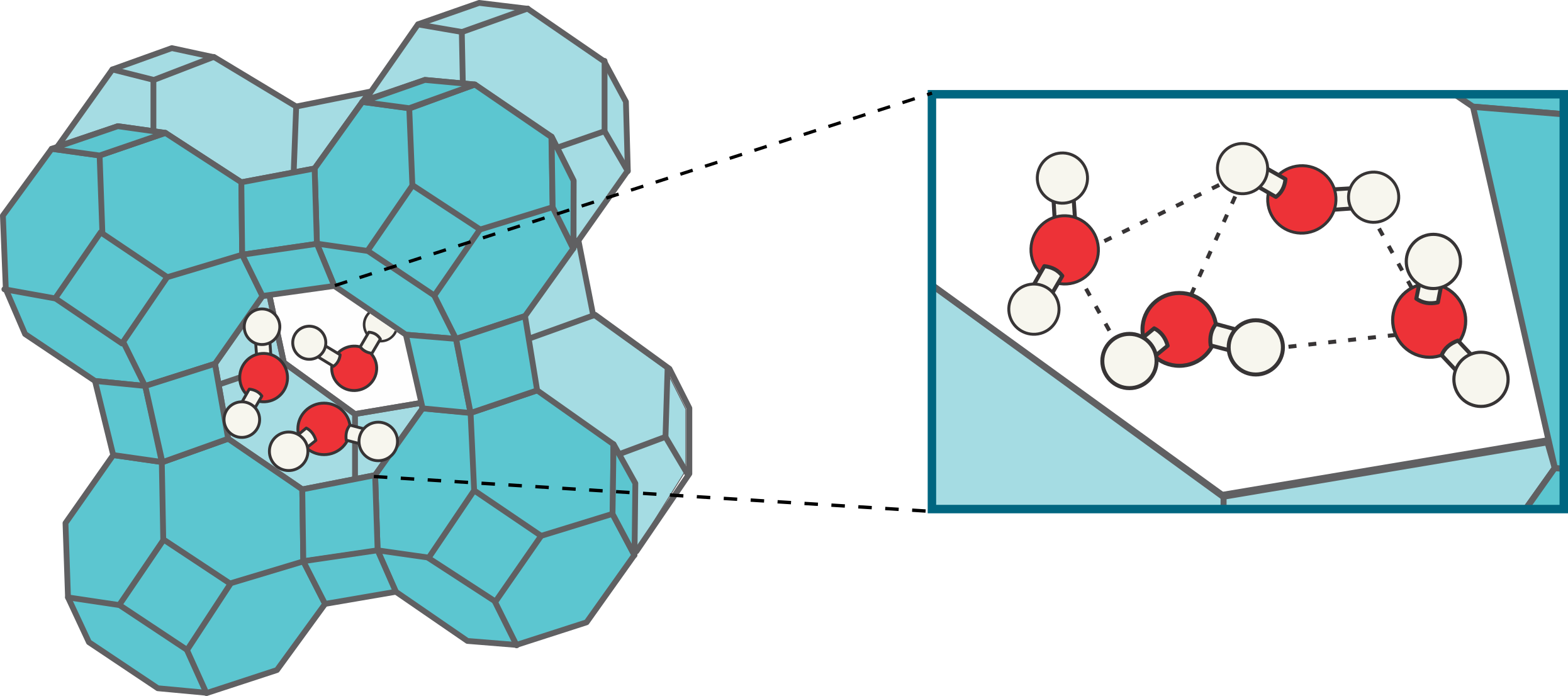Computation and partitioning of nanoconfined water spectra
Computation and partitioning of nanoconfined water spectra
Promotor(en): V. Van Speybroeck /28135 / Nanoporous materials, SpectroscopyBackground and problem
Nanoporous materials that are crystalline and have pores at the nanometer scale possess a wide range of applications ranging from gas separation and sensing to chemical catalysis. Zeolites provide an excellent example, as they play an important role in the storage of thermal energy through the adsorption of water as well as in upcoming technologies to convert biomass or even CO2 into hydrocarbons, the building blocks for polymer synthesis [1]. Given their economic impact, there is a powerful incentive for the characterization and smart design of new functionalized materials to obtain the best material for a given application. From an experimental point of view, it is challenging to obtain insight into the microscopic structure of the material and even more so when guest species, such as water, are adsorbed inside the pores. However, recent advances have made operando spectroscopic measurements possible. Infrared spectroscopy in particular is especially well-suited to track adsorbed molecules in porous materials at operating conditions, although it remains difficult to distinguish experimentally the fingerprint of the adsorbed molecules from the fingerprint of the zeolite framework. In this respect, computational modeling offers a powerful complementary technique. Molecular simulations are able to accurately reproduce experimental spectra and also allow for the assignation of various spectral features to specific molecular motions. Unfortunately, this assignation is still a challenge in complex systems, such as zeolites containing guest species, even with the help of theoretical techniques. On the one hand, the full vibrational spectrum needs to be partitioned into separate vibrational modes that determine molecular motions involved in each mode, which becomes increasingly difficult with increasing system size. On the other hand, the IR intensities have to be calculated for both the zeolite framework and the guest species requiring an expensive quantum mechanical description of the electronic structure.

Goal
In this project the vibrational spectrum of water loaded zeolite frameworks will be calculated and analyzed in detail by means of computational modeling.
The first objective entails the accurate prediction of the IR spectra of zeolite—water systems for different water loadings starting from the electronic Schrödinger equation. Molecular dynamics (MD) simulations will be employed to account for the high mobility of the water molecules. In these MD simulations Newton’s equations of motion are integrated numerically, yielding a trajectory of the atomic positions as a function of time. IR spectra of the zeolite—water systems can subsequently be computed as the Fourier transform of the time-dependent dipole moments [2]. The calculation of the latter by means of ab initio methods has become possible since the development of the modern theory of polarization. By gradually increasing the water content, it will be possible to analyze how water behaves under confinement with the help of IR spectra.
Although straightforward in principle, the calculation of IR spectra of nanoconfined water is rather challenging as the lightweight hydrogen atoms are prone to nuclear quantum effects (NQEs), which are neglected in regular MD simulations. An accurate treatment of the NQEs requires the use of a path integral formalism, in which each atomic nucleus is represented by several replicas connected by harmonic potentials to ensure an appropriate sampling of the nuclear quantum mechanical Hamiltonian. By means of thermostatted ring polymer molecular dynamics (TRPMD) simulations [3] the real-time correlation functions required for the computation of IR spectra can be obtained. Given that every atom is represented by several replicas, these simulations require a tremendous computational effort. Therefore, these highly accurate results will be primarily used to assess the validity of approximating the nuclei as classical particles, as is most commonly done in literature.
As a second objective, an adequate partitioning scheme will be applied to subdivide the IR spectra into its components. Typically, the dipole moment is calculated for the entire unit cell of the periodic system, which does not allow for a straightforward assignation of each peak in the resulting spectrum. Nevertheless, different localization techniques have emerged to solve this problem, including the use of Wannier centers or Voronoi cells. Although these techniques have proven their worth for the interpretation of vibrational spectra of bulk solutions, they have never been used to characterize nanoconfined water. In this project, the performance of such localization schemes within zeolite systems will be assessed and applied.
- Study programmeMaster of Science in Engineering Physics [EMPHYS], Master of Science in Physics and Astronomy [CMFYST]References
[1] Y. Li, L. Li, J. Yu, “Applications of zeolites in sustainable chemistry,” Chem, vol. 3, pp. 928-949, 2017
[2] M. Thomas, M. Brehm, R. Fligg, P. Vöhringer, B. Kirchner, “Computing vibrational spectra from ab initio molecular dynamics,” PhysChemChemPhys, vol. 15, pp. 6608-6622, 2013
[3] M. Rossi, M. Ceriotti, D.E. Manolopoulos, “How to remove the spurious resonances from ring polymer molecular dynamics,” Journal of Chemical Physics, vol. 140, pp. 234116, 2014
